2023届高考英语复习动词的时态语态与主谓一致课件(37张PPT)
文档属性
| 名称 | 2023届高考英语复习动词的时态语态与主谓一致课件(37张PPT) |  | |
| 格式 | pptx | ||
| 文件大小 | 5.3MB | ||
| 资源类型 | 教案 | ||
| 版本资源 | 通用版 | ||
| 科目 | 英语 | ||
| 更新时间 | 2022-11-04 07:24:23 | ||
图片预览




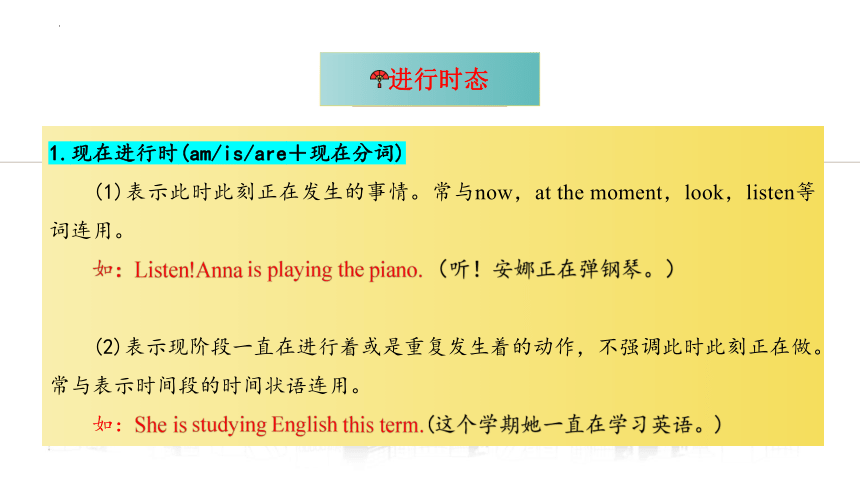
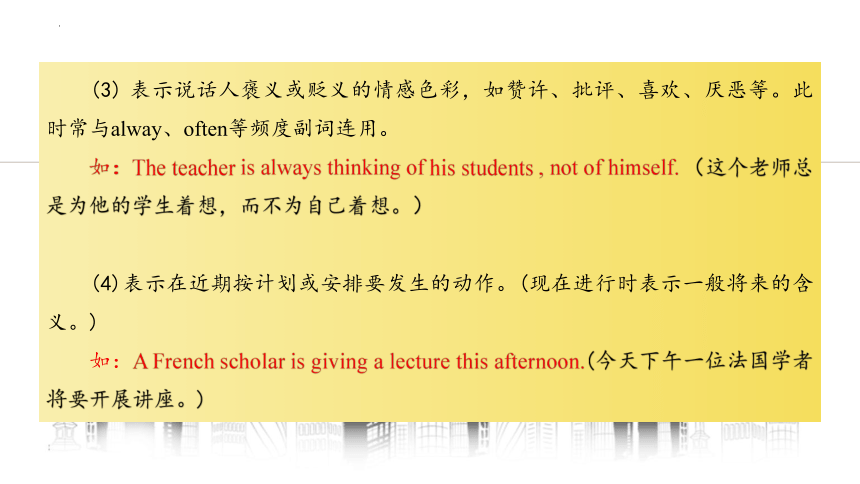

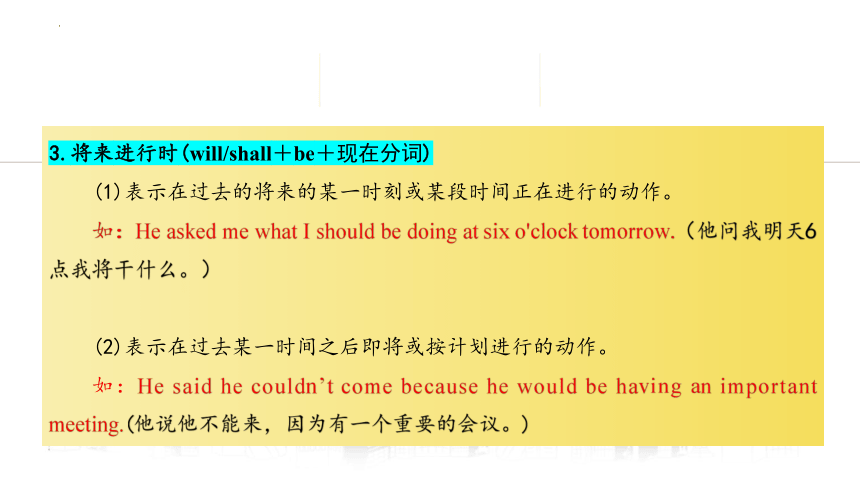
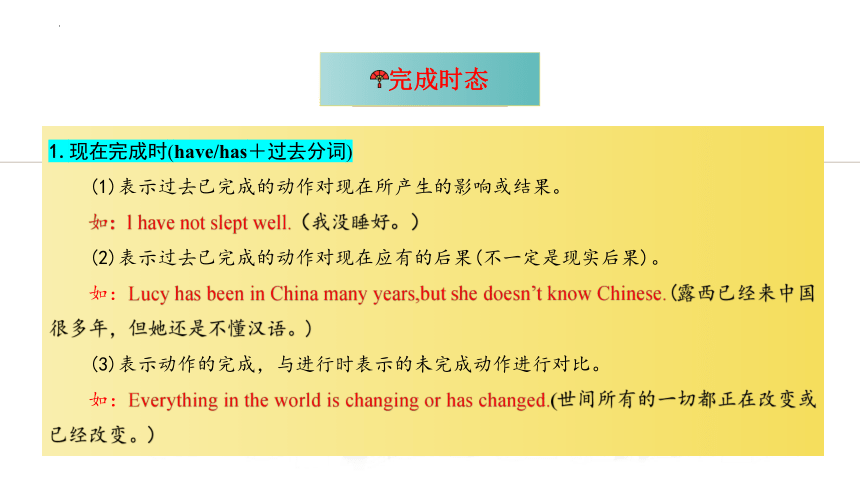
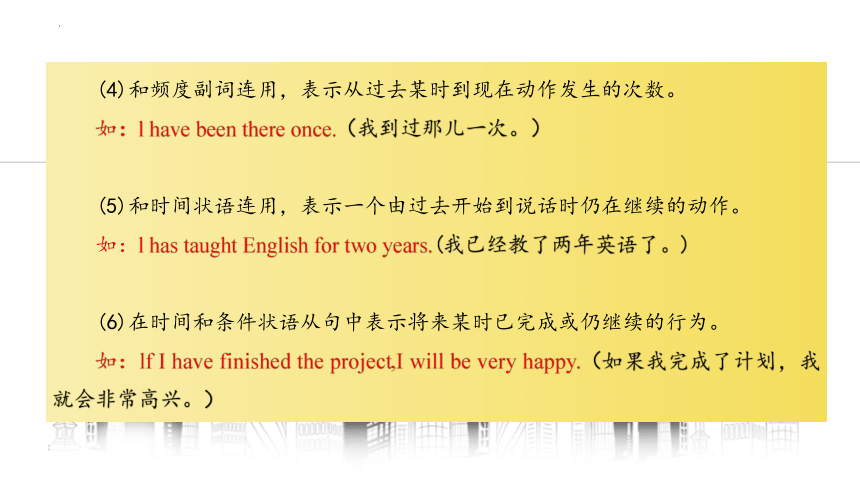
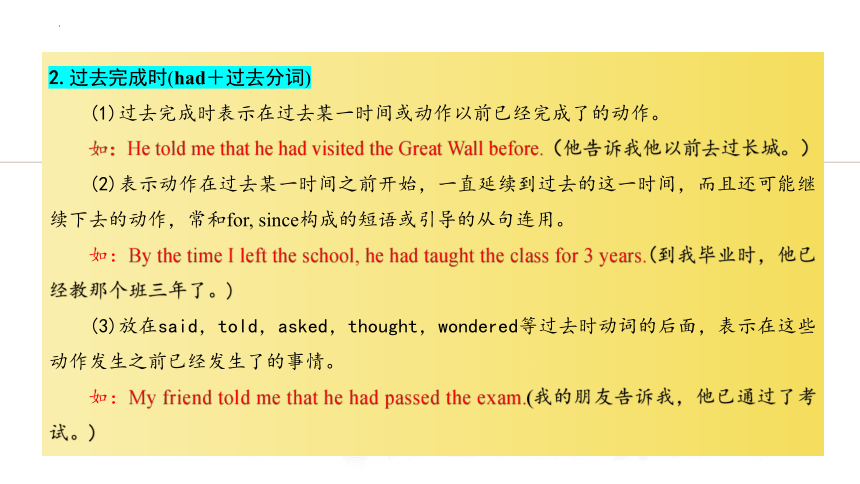
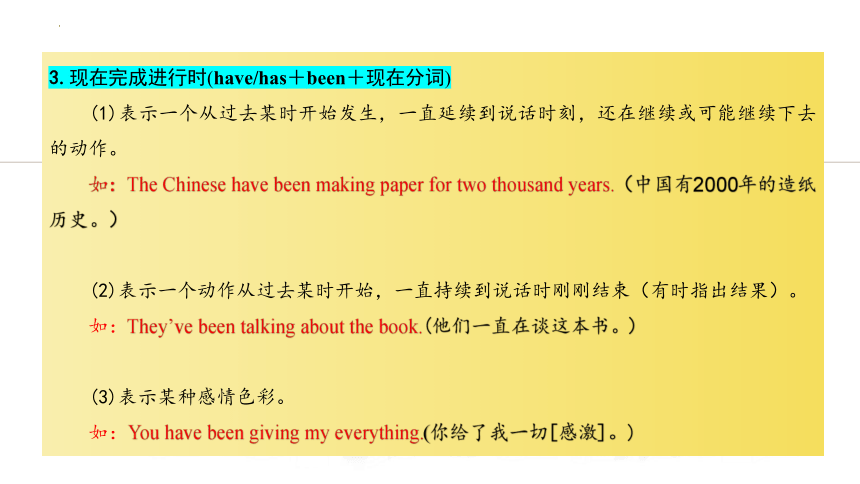
文档简介
(共37张PPT)
动词的时态语态与主谓一致
谓语动词
考点一
动词的时态
1.一般现在时
(1)表示经常性、习惯性、永久性的动作或存在的状态。通常与副词sometimes、often、usually、always、every day、once a day等时间状语连用。
如:We usually go to school by bike.(我们经常骑自行车去上学。)
(2)表示客观真理、科学原理、自然现象等客观事实或格言、谚语等。
如:The sun rises in the east and sets in the west every day.(太阳每天东升西落。)
一般时态
2.一般过去时
(1)表示过去的事实或状态。
如:I was 22 years old last year.(去年我22岁。)
(2)表示在过去某个时间内所做的动作经常与表示过去时间的状语连用。
如:Bob bought a book yesterday.(昨天鲍勃买了一本书。)
1.现在进行时(am/is/are+现在分词)
(1)表示此时此刻正在发生的事情。常与now,at the moment,look,listen等词连用。
如:Listen!Anna is playing the piano. (听!安娜正在弹钢琴。)
(2)表示现阶段一直在进行着或是重复发生着的动作,不强调此时此刻正在做。常与表示时间段的时间状语连用。
如:She is studying English this term.(这个学期她一直在学习英语。)
进行时态
(3) 表示说话人褒义或贬义的情感色彩,如赞许、批评、喜欢、厌恶等。此时常与alway、often等频度副词连用。
如:The teacher is always thinking of his students , not of himself. (这个老师总是为他的学生着想,而不为自己着想。)
(4)表示在近期按计划或安排要发生的动作。(现在进行时表示一般将来的含义。)
如:A French scholar is giving a lecture this afternoon.(今天下午一位法国学者将要开展讲座。)
2.过去进行时(was/were+现在分词)
(1)过去进行时表示过去某段时间内持续进行的动作或者事情。常用的时间状语this morning, the whole morning, all day yesterday, when, while等。
如:Mary is watching TV from eight o'clock to ten o'clock last night.(昨天晚上8点到10点的时候,玛丽在看电视。)
(2)过去进行时可以表示在过去某个时间点发生的事情。时间点可以用介词短语、副词或从句来表示。
如:What were you doing at six o'clock yesterday (昨天晚上6点你在做什么呢?)
(3)在复合句中,如果主要动作和背景动作都是延续的或同时发生的,那么主从句的动词都可用过去进行时。
如:She was watering some trees while I was cleaning the yard.(她浇树时我在打扫院子。)
3.将来进行时(will/shall+be+现在分词)
(1)表示在过去的将来的某一时刻或某段时间正在进行的动作。
如:He asked me what I should be doing at six o'clock tomorrow.(他问我明天6点我将干什么。)
(2)表示在过去某一时间之后即将或按计划进行的动作。
如:He said he couldn’t come because he would be having an important meeting.(他说他不能来,因为有一个重要的会议。)
进行时态
1.现在完成时(have/has+过去分词)
(1)表示过去已完成的动作对现在所产生的影响或结果。
如:l have not slept well.(我没睡好。)
(2)表示过去已完成的动作对现在应有的后果(不一定是现实后果)。
如:Lucy has been in China many years,but she doesn’t know Chinese.(露西已经来中国很多年,但她还是不懂汉语。)
(3)表示动作的完成,与进行时表示的未完成动作进行对比。
如:Everything in the world is changing or has changed.(世间所有的一切都正在改变或已经改变。)
完成时态
(4)和频度副词连用,表示从过去某时到现在动作发生的次数。
如:l have been there once.(我到过那儿一次。)
(5)和时间状语连用,表示一个由过去开始到说话时仍在继续的动作。
如:l has taught English for two years.(我已经教了两年英语了。)
(6)在时间和条件状语从句中表示将来某时已完成或仍继续的行为。
如:lf I have finished the project,I will be very happy.(如果我完成了计划,我就会非常高兴。)
2.过去完成时(had+过去分词)
(1)过去完成时表示在过去某一时间或动作以前已经完成了的动作。
如:He told me that he had visited the Great Wall before.(他告诉我他以前去过长城。)
(2)表示动作在过去某一时间之前开始,一直延续到过去的这一时间,而且还可能继续下去的动作,常和for, since构成的短语或引导的从句连用。
如:By the time I left the school, he had taught the class for 3 years.(到我毕业时,他已经教那个班三年了。)
(3)放在said,told,asked,thought,wondered等过去时动词的后面,表示在这些动作发生之前已经发生了的事情。
如:My friend told me that he had passed the exam.(我的朋友告诉我,他已通过了考试。)
3.现在完成进行时(have/has+been+现在分词)
(1)表示一个从过去某时开始发生,一直延续到说话时刻,还在继续或可能继续下去的动作。
如:The Chinese have been making paper for two thousand years.(中国有2000年的造纸历史。)
(2)表示一个动作从过去某时开始,一直持续到说话时刚刚结束(有时指出结果)。
如:They’ve been talking about the book.(他们一直在谈这本书。)
(3)表示某种感彩。
如:You have been giving my everything.(你给了我一切[感激]。)
(4)表示一个过去动作对现在的影响或造成的结果(相当于现在完成时)。
如:They have been living in this city for ten years. = They have lived in this city for ten years.(他们在这个城市已经住了10年了。)
(5)表示重复。
如:We’ve all long been making mistakes like this.(我们一直在犯这样的错误。)
1.一般将来时
(1)构成:will/shall+动词原形(shall往往与第一人称连用,will与各种人称连用)
(2)用法:常见的有6种表示法
将来时态
2.过去将来时(should/would+动词原形)
(1)过去将来时表示过去习惯性的动作或状态。
如:This door wouldn't open.(这扇门老是打不开。)
(2)过去将来时还可用于间接引语及宾语从句中。
如:I thought he would accept the invitation, but he refused it.(我原以为他会接受邀请,但他拒绝了。)
考点二
动词的语态
英语中的及物动词一般都有主动语态和被动语态两种形式。被动语态由“助动词be+过去分词”构成。助动词be随着主语的人称、数和句子的时态的不同而变化。几种常见时态的被动语态形式见下表:
被动语态的构成
时 体 现在 过去 将来 过去将来
一般 is/am/are done was/were done will/shall be done would/should be done
进行 is/am/are being done was/were being done — —
完成 have/has been done had been done will/shall have been done would/should have been done
1.“系动词look,sound,fell,smell,taste 等+形容词/名词”构成系表结构。
如:The steel feels cold.(钢摸起来很凉。)
2.某些与can’t,won’t 等连用的不及物动词(其主语大多是物),如open,shut,move 等。
如:The door won’t shut.(这扇门关不上。)
3.某些可和well,easily 等副词连用的不及物动词,如read,write, draw,wash,clean,cook,sell 等。
如:Nylon cleans easily.(尼龙容易清洗。)
主动形式表被动意义
考点三
主谓一致
1.动名词、动词不定式、从句、不定代词作主语时,谓语动词常用单数。
如:Having to change trains is a small inconvenience.(换乘火车多少有些不便。)
2.主语后接介词短语或其他插入语,如with,together with,as well as,like,but,except,rather than,in addition to等时,谓语动词的数要与前面的主语保持一致。
如:Tom as well as two of his friends was invited to the party.(汤姆以及他的两个朋友一起被邀请参加聚会了。)
3.and,both...and...连接两个不同的主语,谓语动词用复数形式;但是如果由and连接的两个名词表示同一概念,兼具身份或匹配出现时,谓语动词用单数形式。
如:The singer and dancer is to attend our evening party.(那位歌舞演员将参加我们的晚会。)
语法一致原则
4.定语从句中关系代词作主语时,从句中的谓语动词要与先行词保持一致。
如:My friend showed me around the town,which was very attractive.(我的朋友带我参观了这个小镇,它非常迷人。)
5.“many a/more than one+单数名词”作主语,谓语动词用单数。each,every,no所修饰的名词作主语时,即使有and连接,谓语动词仍用单数。
如:Every boy and every girl wishes to attend the party to be held on Sunday.(每个男生和女生都希望参加即将在周日举办的聚会。)
1.集体名词作主语时,若被看作一个整体,谓语动词用单数形式;若被看作是构成集体的一个个成员,谓语动词用复数形式。常见的集体名词有:family,class,team,group,public,committee,government,audience等。
如:The class consists of 25 boys and 20 girls.(这个班由25个男生和20个女生组成。)
2.“分数/百分数/the majority+of+名词”作主语时,谓语动词的单复数取决于of后名词的数以及其表示的意义;all,some,half,most,the rest等作主语时,谓语动词单复数取决于主语实际表达的意义。
如:About one third of the books are worth reading.(这些书中大约有1/3值得一读。)
3.“the+形容词”表示一类人在句中作主语时,谓语动词用复数形式。
如:The sick have been cured.(病人已被治愈。)
意义一致原则
4.a quantity of后既可接不可数名词,也可接可数名词复数;后接不可数名词时,谓语动词用单数;后接可数名词时,谓语动词用复数。quantities of后无论接可数名词还是接不可数名词,谓语动词均用复数形式。。
如:With more forests being destroyed,huge quantities of good earth are being washed away each year.(由于越来越多的森林被毁,每年有大量的沃土被冲走。)
5.“a number of+复数名词”作主语时,谓语动词用复数形式,“the number of+复数名词”作主语时,谓语动词用单数形式。
如:The number of the students from the north is small.(来自北方的学生人数很少。)
6.表示时间、距离、重量、金额等复数名词作主语时,谓语动词通常用单数形式。
如:Four thousand dollars is quite a lot of money for a boy.(对于一个男孩来说,4000美元是一笔大数目。)
1.由or,either...or...,neither...nor...,not only...but (also)...,not...but...等连接的并列主语,谓语动词的数常与最近的主语保持一致。
如:Either you or one of your students is to attend the meeting that is due tomorrow.(要么是你或者你的一名学生应该出席明天的会议。)
2.由there,here引起的主语不止一个时,谓语动词的数通常和最邻近的主语保持一致。
如:There are three books and a pen on the desk.(桌子上有三本书和一支钢笔。)
就近一致原则
4.a quantity of后既可接不可数名词,也可接可数名词复数;后接不可数名词时,谓语动词用单数;后接可数名词时,谓语动词用复数。quantities of后无论接可数名词还是接不可数名词,谓语动词均用复数形式。。
如:With more forests being destroyed,huge quantities of good earth are being washed away each year.(由于越来越多的森林被毁,每年有大量的沃土被冲走。)
5.“a number of+复数名词”作主语时,谓语动词用复数形式,“the number of+复数名词”作主语时,谓语动词用单数形式。
如:The number of the students from the north is small.(来自北方的学生人数很少。)
6.表示时间、距离、重量、金额等复数名词作主语时,谓语动词通常用单数形式。
如:Four thousand dollars is quite a lot of money for a boy.(对于一个男孩来说,4000美元是一笔大数目。)
语法脉图
典型例题
1.In recent years some Inuit people in Nunavut ____________ (report) increases in bear sightings around human settlements,leading to a belief that populations are increasing.(2019·全国卷Ⅰ)
2.About one month after this photo was took,I entered my second year of high school and became a new member of the school music club.(2017·全国卷Ⅲ)
全国卷真题
1.(1)分析句子成分:some Inuit people作主语, increases作宾语,句子缺少谓语,因此空格处应填谓语动词。
(2)确定时态: 根据句中时间状语In recent years可知,应用现在完成时。
(3)确定语态:主语(people)与谓语(report)是主动关系,应用主动语态。
(4)确定主谓一致。
(5)锁定答案:have reported
2.(1)把握时态:根据主句的并列谓语entered和became可知应用一般过去时。
(2)判断语态:this photo与take之间为被动关系,因此应使用一般过去时的被动语态。
(3)锁定答案:took→taken
答案解析
Thank you!
动词的时态语态与主谓一致
谓语动词
考点一
动词的时态
1.一般现在时
(1)表示经常性、习惯性、永久性的动作或存在的状态。通常与副词sometimes、often、usually、always、every day、once a day等时间状语连用。
如:We usually go to school by bike.(我们经常骑自行车去上学。)
(2)表示客观真理、科学原理、自然现象等客观事实或格言、谚语等。
如:The sun rises in the east and sets in the west every day.(太阳每天东升西落。)
一般时态
2.一般过去时
(1)表示过去的事实或状态。
如:I was 22 years old last year.(去年我22岁。)
(2)表示在过去某个时间内所做的动作经常与表示过去时间的状语连用。
如:Bob bought a book yesterday.(昨天鲍勃买了一本书。)
1.现在进行时(am/is/are+现在分词)
(1)表示此时此刻正在发生的事情。常与now,at the moment,look,listen等词连用。
如:Listen!Anna is playing the piano. (听!安娜正在弹钢琴。)
(2)表示现阶段一直在进行着或是重复发生着的动作,不强调此时此刻正在做。常与表示时间段的时间状语连用。
如:She is studying English this term.(这个学期她一直在学习英语。)
进行时态
(3) 表示说话人褒义或贬义的情感色彩,如赞许、批评、喜欢、厌恶等。此时常与alway、often等频度副词连用。
如:The teacher is always thinking of his students , not of himself. (这个老师总是为他的学生着想,而不为自己着想。)
(4)表示在近期按计划或安排要发生的动作。(现在进行时表示一般将来的含义。)
如:A French scholar is giving a lecture this afternoon.(今天下午一位法国学者将要开展讲座。)
2.过去进行时(was/were+现在分词)
(1)过去进行时表示过去某段时间内持续进行的动作或者事情。常用的时间状语this morning, the whole morning, all day yesterday, when, while等。
如:Mary is watching TV from eight o'clock to ten o'clock last night.(昨天晚上8点到10点的时候,玛丽在看电视。)
(2)过去进行时可以表示在过去某个时间点发生的事情。时间点可以用介词短语、副词或从句来表示。
如:What were you doing at six o'clock yesterday (昨天晚上6点你在做什么呢?)
(3)在复合句中,如果主要动作和背景动作都是延续的或同时发生的,那么主从句的动词都可用过去进行时。
如:She was watering some trees while I was cleaning the yard.(她浇树时我在打扫院子。)
3.将来进行时(will/shall+be+现在分词)
(1)表示在过去的将来的某一时刻或某段时间正在进行的动作。
如:He asked me what I should be doing at six o'clock tomorrow.(他问我明天6点我将干什么。)
(2)表示在过去某一时间之后即将或按计划进行的动作。
如:He said he couldn’t come because he would be having an important meeting.(他说他不能来,因为有一个重要的会议。)
进行时态
1.现在完成时(have/has+过去分词)
(1)表示过去已完成的动作对现在所产生的影响或结果。
如:l have not slept well.(我没睡好。)
(2)表示过去已完成的动作对现在应有的后果(不一定是现实后果)。
如:Lucy has been in China many years,but she doesn’t know Chinese.(露西已经来中国很多年,但她还是不懂汉语。)
(3)表示动作的完成,与进行时表示的未完成动作进行对比。
如:Everything in the world is changing or has changed.(世间所有的一切都正在改变或已经改变。)
完成时态
(4)和频度副词连用,表示从过去某时到现在动作发生的次数。
如:l have been there once.(我到过那儿一次。)
(5)和时间状语连用,表示一个由过去开始到说话时仍在继续的动作。
如:l has taught English for two years.(我已经教了两年英语了。)
(6)在时间和条件状语从句中表示将来某时已完成或仍继续的行为。
如:lf I have finished the project,I will be very happy.(如果我完成了计划,我就会非常高兴。)
2.过去完成时(had+过去分词)
(1)过去完成时表示在过去某一时间或动作以前已经完成了的动作。
如:He told me that he had visited the Great Wall before.(他告诉我他以前去过长城。)
(2)表示动作在过去某一时间之前开始,一直延续到过去的这一时间,而且还可能继续下去的动作,常和for, since构成的短语或引导的从句连用。
如:By the time I left the school, he had taught the class for 3 years.(到我毕业时,他已经教那个班三年了。)
(3)放在said,told,asked,thought,wondered等过去时动词的后面,表示在这些动作发生之前已经发生了的事情。
如:My friend told me that he had passed the exam.(我的朋友告诉我,他已通过了考试。)
3.现在完成进行时(have/has+been+现在分词)
(1)表示一个从过去某时开始发生,一直延续到说话时刻,还在继续或可能继续下去的动作。
如:The Chinese have been making paper for two thousand years.(中国有2000年的造纸历史。)
(2)表示一个动作从过去某时开始,一直持续到说话时刚刚结束(有时指出结果)。
如:They’ve been talking about the book.(他们一直在谈这本书。)
(3)表示某种感彩。
如:You have been giving my everything.(你给了我一切[感激]。)
(4)表示一个过去动作对现在的影响或造成的结果(相当于现在完成时)。
如:They have been living in this city for ten years. = They have lived in this city for ten years.(他们在这个城市已经住了10年了。)
(5)表示重复。
如:We’ve all long been making mistakes like this.(我们一直在犯这样的错误。)
1.一般将来时
(1)构成:will/shall+动词原形(shall往往与第一人称连用,will与各种人称连用)
(2)用法:常见的有6种表示法
将来时态
2.过去将来时(should/would+动词原形)
(1)过去将来时表示过去习惯性的动作或状态。
如:This door wouldn't open.(这扇门老是打不开。)
(2)过去将来时还可用于间接引语及宾语从句中。
如:I thought he would accept the invitation, but he refused it.(我原以为他会接受邀请,但他拒绝了。)
考点二
动词的语态
英语中的及物动词一般都有主动语态和被动语态两种形式。被动语态由“助动词be+过去分词”构成。助动词be随着主语的人称、数和句子的时态的不同而变化。几种常见时态的被动语态形式见下表:
被动语态的构成
时 体 现在 过去 将来 过去将来
一般 is/am/are done was/were done will/shall be done would/should be done
进行 is/am/are being done was/were being done — —
完成 have/has been done had been done will/shall have been done would/should have been done
1.“系动词look,sound,fell,smell,taste 等+形容词/名词”构成系表结构。
如:The steel feels cold.(钢摸起来很凉。)
2.某些与can’t,won’t 等连用的不及物动词(其主语大多是物),如open,shut,move 等。
如:The door won’t shut.(这扇门关不上。)
3.某些可和well,easily 等副词连用的不及物动词,如read,write, draw,wash,clean,cook,sell 等。
如:Nylon cleans easily.(尼龙容易清洗。)
主动形式表被动意义
考点三
主谓一致
1.动名词、动词不定式、从句、不定代词作主语时,谓语动词常用单数。
如:Having to change trains is a small inconvenience.(换乘火车多少有些不便。)
2.主语后接介词短语或其他插入语,如with,together with,as well as,like,but,except,rather than,in addition to等时,谓语动词的数要与前面的主语保持一致。
如:Tom as well as two of his friends was invited to the party.(汤姆以及他的两个朋友一起被邀请参加聚会了。)
3.and,both...and...连接两个不同的主语,谓语动词用复数形式;但是如果由and连接的两个名词表示同一概念,兼具身份或匹配出现时,谓语动词用单数形式。
如:The singer and dancer is to attend our evening party.(那位歌舞演员将参加我们的晚会。)
语法一致原则
4.定语从句中关系代词作主语时,从句中的谓语动词要与先行词保持一致。
如:My friend showed me around the town,which was very attractive.(我的朋友带我参观了这个小镇,它非常迷人。)
5.“many a/more than one+单数名词”作主语,谓语动词用单数。each,every,no所修饰的名词作主语时,即使有and连接,谓语动词仍用单数。
如:Every boy and every girl wishes to attend the party to be held on Sunday.(每个男生和女生都希望参加即将在周日举办的聚会。)
1.集体名词作主语时,若被看作一个整体,谓语动词用单数形式;若被看作是构成集体的一个个成员,谓语动词用复数形式。常见的集体名词有:family,class,team,group,public,committee,government,audience等。
如:The class consists of 25 boys and 20 girls.(这个班由25个男生和20个女生组成。)
2.“分数/百分数/the majority+of+名词”作主语时,谓语动词的单复数取决于of后名词的数以及其表示的意义;all,some,half,most,the rest等作主语时,谓语动词单复数取决于主语实际表达的意义。
如:About one third of the books are worth reading.(这些书中大约有1/3值得一读。)
3.“the+形容词”表示一类人在句中作主语时,谓语动词用复数形式。
如:The sick have been cured.(病人已被治愈。)
意义一致原则
4.a quantity of后既可接不可数名词,也可接可数名词复数;后接不可数名词时,谓语动词用单数;后接可数名词时,谓语动词用复数。quantities of后无论接可数名词还是接不可数名词,谓语动词均用复数形式。。
如:With more forests being destroyed,huge quantities of good earth are being washed away each year.(由于越来越多的森林被毁,每年有大量的沃土被冲走。)
5.“a number of+复数名词”作主语时,谓语动词用复数形式,“the number of+复数名词”作主语时,谓语动词用单数形式。
如:The number of the students from the north is small.(来自北方的学生人数很少。)
6.表示时间、距离、重量、金额等复数名词作主语时,谓语动词通常用单数形式。
如:Four thousand dollars is quite a lot of money for a boy.(对于一个男孩来说,4000美元是一笔大数目。)
1.由or,either...or...,neither...nor...,not only...but (also)...,not...but...等连接的并列主语,谓语动词的数常与最近的主语保持一致。
如:Either you or one of your students is to attend the meeting that is due tomorrow.(要么是你或者你的一名学生应该出席明天的会议。)
2.由there,here引起的主语不止一个时,谓语动词的数通常和最邻近的主语保持一致。
如:There are three books and a pen on the desk.(桌子上有三本书和一支钢笔。)
就近一致原则
4.a quantity of后既可接不可数名词,也可接可数名词复数;后接不可数名词时,谓语动词用单数;后接可数名词时,谓语动词用复数。quantities of后无论接可数名词还是接不可数名词,谓语动词均用复数形式。。
如:With more forests being destroyed,huge quantities of good earth are being washed away each year.(由于越来越多的森林被毁,每年有大量的沃土被冲走。)
5.“a number of+复数名词”作主语时,谓语动词用复数形式,“the number of+复数名词”作主语时,谓语动词用单数形式。
如:The number of the students from the north is small.(来自北方的学生人数很少。)
6.表示时间、距离、重量、金额等复数名词作主语时,谓语动词通常用单数形式。
如:Four thousand dollars is quite a lot of money for a boy.(对于一个男孩来说,4000美元是一笔大数目。)
语法脉图
典型例题
1.In recent years some Inuit people in Nunavut ____________ (report) increases in bear sightings around human settlements,leading to a belief that populations are increasing.(2019·全国卷Ⅰ)
2.About one month after this photo was took,I entered my second year of high school and became a new member of the school music club.(2017·全国卷Ⅲ)
全国卷真题
1.(1)分析句子成分:some Inuit people作主语, increases作宾语,句子缺少谓语,因此空格处应填谓语动词。
(2)确定时态: 根据句中时间状语In recent years可知,应用现在完成时。
(3)确定语态:主语(people)与谓语(report)是主动关系,应用主动语态。
(4)确定主谓一致。
(5)锁定答案:have reported
2.(1)把握时态:根据主句的并列谓语entered和became可知应用一般过去时。
(2)判断语态:this photo与take之间为被动关系,因此应使用一般过去时的被动语态。
(3)锁定答案:took→taken
答案解析
Thank you!
